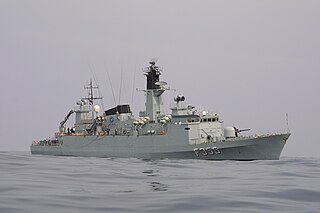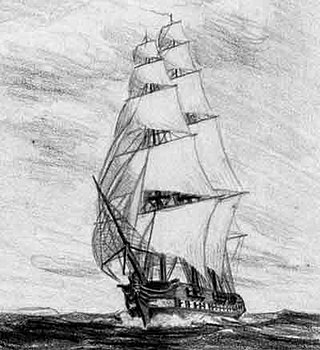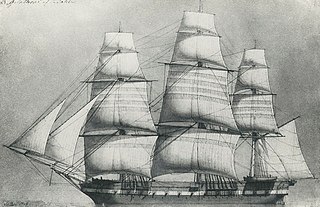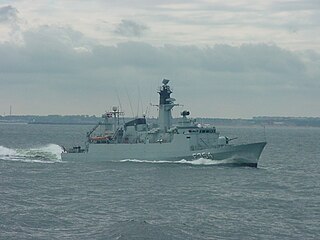The Danish Armed Forces is the unified armed forces of the Kingdom of Denmark charged with the defence of Denmark and its self-governing territories Greenland and the Faroe Islands. The military also promote Denmark's wider interests, support international peacekeeping efforts and provide humanitarian aid.

The Delfinen-class submarines were the first class of submarines constructed for the Royal Danish Navy following World War II. They were designed and built within Denmark, with first three boats of the class financed by Denmark. The fourth was financed by the United States under the Cost Share program. Constructed between 1956 and 1963, the class comprising four submarines entered service in 1961 and the last taken out of service in 1990. Replaced by the Norwegian Kobben class, three of them were scrapped while a fourth was converted into a museum ship and remains on display at the Aalborg Maritime Museum.

HDMS Olfert Fischer (F355) was a Niels Juel-class corvette of the Kongelige Danske Marine. The vessel was laid down in December 1978 and commissioned in October 1981. The corvette operated in the Persian Gulf on two occasions, first in 1990 and 1991 as part of the multinational fleet enforcing the United Nations sanctions against Iraq, then again in 2003 in support of the United States-led invasion of Iraq. Olfert Fischer was deployed as part of the NATO Standing Naval Force Atlantic on at least four occasions during her career.
The Royal Danish Navy ranks follows the NATO system of ranks and insignia, as does the rest of the Danish Defence. Outside this ranking system there are physicians, nurses and veterinarians, while priests and judicial personnel wear completely different insignia and are without rank.
The following ships of the Royal Danish Navy have borne the name HDMS Diana:

HDMS Bellona was a frigate of the Royal Danish Navy, which she served from 1835 to 1862.

HDMS Havfruen was a frigate of the Royal Danish Navy.
The following ships of the Royal Danish Navy have borne the name HDMS Bellona:
The following ships of the Royal Danish Navy have borne the name HDMS Flora:

HDMS Galathea was a three-masted corvette of the Royal Danish Navy, constructed at Gammelholm to designs by Andreas Shifter in 1831. She is above all remembered for being the ship that undertook the First Galathea Expedition, 1845–1847. On two occasions, first in 1833 and later in 1839, Galathea was also instrumental in picking some of Bertel Thorvaldsen's artworks up in Rome and bringing them back to Denmark.

The Diana class, also known as the Minor Standard Craft Mk II, are a class of six patrol boats in service with the Royal Danish Navy. Built by Faaborg Værft A/S, the ships displace 280 tonnes and have a maximum speed of 18 knots knots. The class was intended to replace the aging Barsø class of patrol boats. The lead ship of the class, HDMS Diana, entered Danish service in 2007. The Diana-class vessels were initially tasked with fisheries protection, patrol and search and rescue but are currently tasked with international and combat operations.

HDMS Herluf Trolle (F353) was a Peder Skram-class frigate in the Royal Danish Navy which was in use until 1990. The ship is named after Herluf Trolle, a 15th-century Danish admiral.

HDMS Niels Juel (F354) was a Niels Juel-class corvette in the Royal Danish Navy which was in use until 1990. The ship was named after Niels Juel, a 16th-century Danish admiral.

HDMS Peter Tordenskiold (F356) was a Niels Juel-class corvette in the Royal Danish Navy which was in use until 1990. The ship is named after Peter Tordenskjold, a 17th-century Dano-Norwegian vice admiral.
A number of vessels of the Royal Danish Navy have borne the name Peter Tordenskjold, after Peter Tordenskjold.
A number of vessels of the Royal Danish Navy have borne the name Peter Willemoes, after Peter Willemoes.
A number of vessels of the Royal Danish Navy have borne the name Iver Huitfeldt, after Iver Huitfeldt.

Submarines in the Royal Danish Navy were introduced in 1909, with various models in service all the way up to 2004. Danish submarines had been operated thru many developments in submarine technology, and in the 21st century was operating three submarines. Conventionally powered submarines were operated, including a unique littoral submarine used in shallower coastal waters. Overall, the Navy relied on the submarines of NATO partners in the region and its other naval assets to achieve a cost saving. After twenty years, with the replacement of Thetis-class patrol frigate and rising defense budgets, discussion are occurring to bring back this weapon systems as part of its overall naval structure. Without submarines, other Naval assets such as ASW helicopters and naval assets fill in the defense picture. Not operating submarines did not mean an end to concerns about ASW defense.










